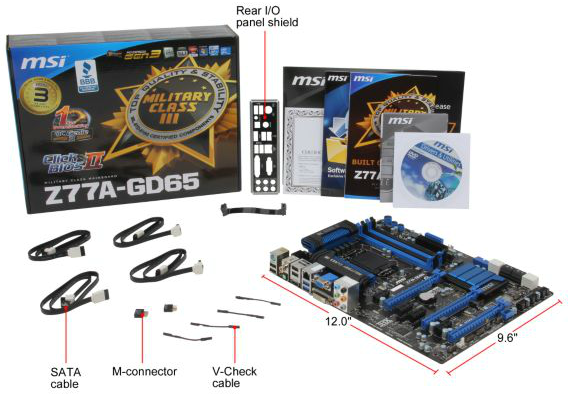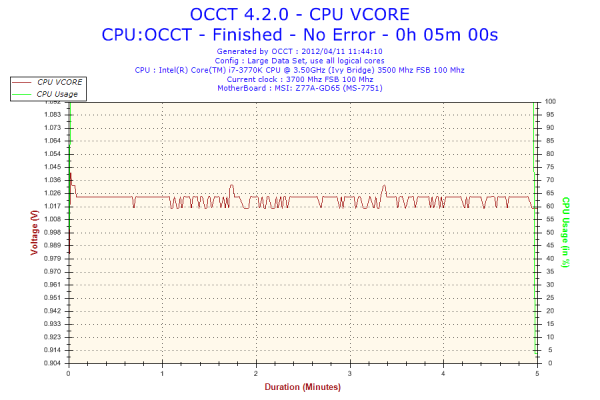Intel Z77 Motherboard Review with Ivy Bridge - ASRock, ASUS, Gigabyte, and MSI
by Ian Cutress on May 7, 2012 7:40 PM EST- Posted in
- Motherboards
- MSI
- Gigabyte
- ASRock
- Asus
- Ivy Bridge
- Z77
MSI Z77A-GD65 - In The Box
The MSI Z77A-GD65 is currently available for $190, just north of the Gigabyte board. With this in mind, we also get a few more extras in the box than the Gigabyte:
IO Shield
Driver CD
User Manual
Certification of Military Class testing (FWIW)
Four SATA cables
Flexi-SLI bridge
M-Connectors (to help front panel connections)
V-Check cables (to help with voltage read points)

Voltage Readings
Using OCCT we monitor the voltage change of the motherboard under load. This represents the direct correlation between the Load Line Calibration and how the processor/motherboard deals with voltage requests while under load. This is not to be confused with the quality of power delivery, but more an indication of how aggressive the default LLC settings are on a motherboard.
Similarly to the ASUS board in this review, the MSI has minor variations in the CPU voltage. Worthy of note though is the lower VCore used by the MSI board compared to the other boards in this review while at load, suggesting more aggressive LLC settings.
Overclocking
Note: Ivy Bridge does not overclock like Sandy Bridge. For a detailed report on the effect of voltage on Ivy Bridge (and thus temperatures and power draw), please read Undervolting and Overclocking on Ivy Bridge.
Overclocking options on the MSI Z77A-GD65 are relatively straightforward. With the OC Genie button on board, give it a press and it lights up, causing the next boot to initialize a series of predefined settings for an overclock. Manual overclocks can be done by the Click BIOS software in the operating system, or by adjusting the BIOS directly.
Automatic Overclocking: After pressing the OC Genie button, it essentially seemed to enable the Enhanced Turbo option in the BIOS. The system booted without issue, and I was greeted with a 39x multiplier under all loads, showing 1.080 volts and 65ºC with PovRay. This is a rather disappointing automatic overclock. This is also indicative of issues relating to one button overclocks - the manufacturer is supplying a series of presets that has to work on every processor out of the factory. It is perhaps time that MSI introduces their own stress-testing overclock into the mix to get a better result.
Manual Overclock: Given the previous overclocking results achieved, with the MSI board we jumped straight in with 1.2 volts, with PLL Overvoltage enabled just for good measure. At this voltage, 46x multiplier was the highest multiplier stable, giving 82ºC with PovRay and showing 1.184 volts at load. In order to get the 47x multiplier to work, it required 1.250 volts on the CPU, although this gave 90ºC during PovRay and 1.240 volts at load.











117 Comments
View All Comments
Jase89 - Sunday, May 19, 2013 - link
Having RAID Option ROM Supported in UEFI as well (people using RAID) is a very good thing ASRock have done with their Z77 series, wonder when Gigabyte will add this feature, http://www.youtube.com/watch?v=Y1TbdVtAE9cgramboh - Tuesday, May 8, 2012 - link
Just wanted to add that my new P8Z77-V Pro POSTS significantly faster than what Ian experienced in this review, probably due to my configuration:Intel SATA: AHCI
ASmedia USB3: on
ASmedia SATA controller: off
Wifi: off
Onboard sound: off
My total time from splash screen to Windows 7 Pro x64 login is 15 seconds on a Mushkin Chronos Deluxe 240GB. The post is about 6 seconds (hand timing these). It's unfortunately the other controllers add ~14 seconds of POST time.
IanCutress - Tuesday, May 8, 2012 - link
Hi Gramboh,Disabling ASMedia SATA, Wifi and Sound would obviously decrease POST time by quite a bit! As I doubt the majority of non-enthusiast buyers would go into the BIOS and disable what they don't need, I kept the start up sequence the same as default to reflect this.
Ian
DanNeely - Tuesday, May 8, 2012 - link
A large number of your readers are enthusiasts. Giving both sets of numbers would be beneficial for us. A per onboard device breakdown of boot time would be nice; but probably too much work to be justified.IanCutress - Tuesday, May 8, 2012 - link
I've added 'POST Quick' to my internal database of testing, with the aim to turn off all I can to observe POST times. Will be applied from the next review onwards, perhaps retroactively if I get time.Ian
AlexIsAlex - Wednesday, May 9, 2012 - link
Awesome, thank you so much!Perhaps the manufacturers will pay attention to this too :-)
Paapaa125 - Wednesday, May 9, 2012 - link
I think most Anandtech readers DO go to BIOS to set things up. I think it is crucial to know if the differences in performance (boot time, benchmarks, power consumption etc) can be minimized just by changing BIOS settings. That would make it a lot easier to buy a new board.I have seen reports that some boards don't follow the Intel specs regarding Turbo Boost settings and utilize higher frequency with all cores utilized. This skews the performance results greatly. Those following the specs get worse results - yet they could be configured for exact same performance.
dananski - Tuesday, May 8, 2012 - link
Makes me really glad to have ordered the ASRock, though I wonder how it would be affected by having RAID enabled? My GA-P35C-DS3R takes about a minute to get through POST and RAID screens.I am also confused why even the quick one is taking so long. My laptops take less than 5 secs to POST :/
EnzoFX - Monday, May 7, 2012 - link
ATX just seems like it's for bragging rights, and not even directly so, simply because you'll be able to say you have so many things connected, maybe you even have tri or quad SLI, all in a huge case. Can we get some coverage of mATX boards?On another note, something that drives me nuts is the AHCI driver loading at POST. Last time I checked I couldn't find a straight answer, does this loading stage still happen in ivy bridge? Of course you don't have to use AHCI, but it really should be standard and enabled by default. At least for anyone spending this much on a motherboard.
EnzoFX - Monday, May 7, 2012 - link
"Conclusion – Gigabyte MSI Z77A-GD65"One more rant lol. Is having all 4 video outputs really a feature? Is this not targeted at people who will be using their own graphics card? In which case they only serve to use up space that could be used towards USB ports or something else that's almost as useful. Remember before P55, 10 usb ports were starting to be the average on a feature filled board, now we have to settle for 6-8. Unless you want to spend top dollar for more.